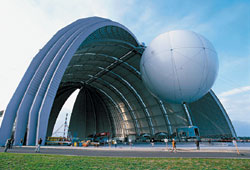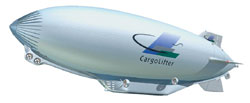International
Lighter-than-air transport nears for Canadian oil field. For readers who thought that the era of airships as viable transportation ended with the Hindenburg crash in 1937, guess again. Not only are airships good for more than airborne billboards, a German firm has taken an intermediate step to bring lighter-than-air applications to oil field transport. On March 16, Berlin-based CargoLifter AG achieved a breakthrough, selling its first CL 75 AirCrane transportation balloon to Calgary’s Heavy Lift Canada (HLC), Inc. HLC will use the CL 75 to transport oilfield equipment and supplies into remote, northern Canada, as in the Mackenzie Delta. CargoLifter was founded by 93 shareholders in 1996, to develop, construct, operate and market large airships for global transportation of large, heavy goods. In addition, the firm has developed a division that offers logistical and transportation services planning, utilizing traditional conveyance modes along with airships.
The company designed the CL 75 as part of overall development of the CL 160 FlyingCrane airship. A project was also launched to build a smaller, 1:8-scale version of the CL 160, nicknamed the Joey project. Construction of airship Joey began in 1997, and the airship’s maiden voyage was on Oct. 18, 1999. So far, it has proven the merit of the larger CL 160 concept. To aid the CL 160’s development, a large airship hanger was constructed at Briesen-Brand in Brandenburg state and completed in November 2000. Measuring 360 by 210 by 107 m, it is the world’s largest freestanding hanger. As regards the CL 75, the 61-m balloon can handle loads up to 75 metric t, with dimensions as large as 13 m long, 6 m wide and 6 m high. Range at maximum payload is 250 km. HLC identified an opportunity to use the CL 75 to extend Canada’s short drilling season. At present, heavy transport trucks can use ice roads in northern Canada for only a 90-day drilling season. Moreover, they can only use ice roads that have a thickness of 1.2 m or greater. The CL 75 will be used to suspend an equipment load in the air, with a towrope attached to a specialized ground vehicle. The vehicle will then tow the suspended load, resulting in a much-reduced impact on the road and surrounding terrain. Less impact means longer ice road life. "This gives the system’s users a big advantage," said HLC CEO John Angus. "The CL 75 will considerably extend the drilling season. Drilling companies can set up their equipment while being less constrained by external conditions." HLC believes that the concept can be applied equally to conditions in Alaska. HLC’s deal with CargoLifter includes the sale of one AirCrane balloon, with an option to purchase 25 additional examples, at US$10 million, each. CL 160 development is proceeding at Brand, where 284 of 502 company employees are working. The airship will measure 260 m long and 65 m wide, and haul loads up to 160 metric t. Commercial production should begin in 2005 or 2006. Chavez sets a comeback record. "The third time is the charm," took on new meaning for this editor when applied to the Venezuelan section of this column page for May. The original version was written just after President Hugo Chavez answered protests about his puppet board at state oil firm PDVSA by firing seven executives and forcing others to retire. Resultant strikes and violence (16 deaths) pointed to an economic crippling and disruption of oil exports. Ah, not so fast. This column originally ended with a wish that Venezuelans would band together and force Chavez from office. Sure enough, 48 hours later on April 11, senior military leaders entered the presidential palace, forced Chavez to resign and arrested him. Early on April 12, these commanders installed business leader Pedro Carmona as interim president. However, Carmona miscalculated by immediately dissolving all branches of government. He also failed to appreciate the depth of Chavez’s hard-core support. Meanwhile, yours truly, thinking that the new regime might be more competent than it proved to be, tore up the original column and wrote a second version. A day later, on Saturday, yet another surprise occurred. Pro-Chavez protestors joined with junior military commanders in the streets to demand his return. Violence broke out again, and another 49 people died. Thus, the handwriting was on the wall – the new regime did not have enough support among the population. The military withdrew its support, and Carmona resigned after just two days as president. Early on Sunday, April 14, Chavez was freed from detention and flown by helicopter, back to the presidential palace. The dizzying pace shocked the usually bombastic Chavez. "I confess that I am still stupefied," he said. So is the rest of the world. Never before in modern history had a South American ruler been deposed, only to return to power in just two days. Chavez and the opposition must now mend fences hurriedly, and work together to shore up the shaky Venezuelan economy. Chavez is also an ardent OPEC supporter and oil price hawk, so the country is almost certain not to overproduce. As for Chavez’s record turnaround that forced this column to be written a record three times, this WILL be the page’s final edition. If Venezuelans want to indulge in another coup attempt, they can do it on their own – this editor is too tired to care.
|
- Prices and governmental policies combine to stymie Canadian upstream growth (February 2024)
- U.S. producing gas wells increase despite low prices (February 2024)
- U.S. drilling: More of the same expected (February 2024)
- U.S. oil and natural gas production hits record highs (February 2024)
- U.S. upstream muddles along, with an eye toward 2024 (September 2023)
- Canada's upstream soldiers on despite governmental interference (September 2023)





